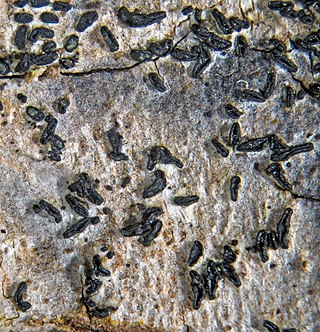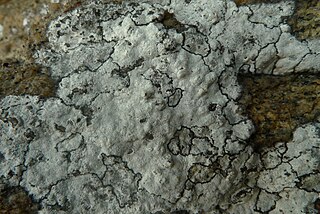
The Arthoniales is the second largest order of mainly crustose lichens, but fruticose lichens are present as well. The order contains around 1500 species, while the largest order with lichenized fungi, the Lecanorales, contains more than 14000 species.

The Roccellaceae are a family of fungi in the order Arthoniomycetes. Most taxa are lichenized with green algae, although some are lichenicolous, growing on other lichens.

Enterographa is a genus of lichens in the family Roccellaceae.

Lecanographa is a genus of about 40 species of lichens in the family Lecanographaceae. It was circumscribed in 1994 by José M. Egea and Pilar Torrente, with Lecanographa lyncea as the type species.

Lecanactis is a genus of crustose lichens, commonly called old wood rimmed lichen. The genus was circumscribed in 1855 by German lichenologist Gustav Wilhelm Körber, who assigned Lecanactis abietina as the type species.

Alyxoria is a genus of lichen-forming fungi in the family Lecanographaceae.

Roccellographaceae is a family of lichen-forming fungi in the order Arthoniales. It contains three genera: Dimidiographa, Fulvophyton, and Roccellographa.
Vigneronia is a genus of lichen-forming fungi in the family Roccellaceae. It has five species. The genus was circumscribed in 2014 by Damien Ernst, with Vigneronia spieri assigned as the type species. This species, originally described as Schismatomma spieri from collections made in the Galápagos Islands, has since been recorded from mainland Ecuador and the Antilles (Curaçao). The genus is named after Ernst's wife, Nathalie Vigneron, who accompanied him on collecting trips.
Gyrographa is a genus of lichen-forming fungi in the family Roccellaceae. The genus was circumscribed in 2014 by Damien Ernst and Anders Tehler, with Gyrographa gyrocarpa assigned as the type species. This lichen, originally described by Julius von Flotow in 1825, was first placed in the genus Opegrapha. Species in the genus have a crustose thallus lacking a cortex, and a dark brown prothallus. The photobiont partner is trentepholioid. The hypothecium is thick and carbonised, and the ascospores lack a gelatinous sheath; these characteristics distinguish it from Opegrapha species. The genus name alludes to the gyrose ascomata of the type species.
Diromma is a monotypic fungal genus in the family Roccellaceae. It contains the single species Diromma dirinellum, a rare crustose lichen that grows as a parasite on the lichen Dirina ceratoniae. It has a distribution restricted to the Mediterranean Basin.
Dirina badia is a species of crustose lichen in the family Roccellaceae. It is found on the small desert mountains of northern Peru, where it grows on both stone and on bark.
Dirina cretacea is a species of saxicolous (rock-dwelling), crustose lichen in the family Roccellaceae. Its distribution is largely in the eastern Mediterranean, and in Andalusia, Spain. It was formally described as a new species in 1899 by Alexander Zahlbruckner as a member of the genus Chiodecton. The type specimen was collected in Croatia. Anders Tehler transferred it to the genus Dirina in 1983. The lichen has a whitish-grey thallus lacking soralia, and a chalk-like medulla. Its ascomata have a circular outline and a diameter of up to 3.8 mm; the apothecial disc is also white grey with a layer of pruina, and is surrounded by a thalline margin. Ascospores measure 19–23 by 5–6 μm.
Vigneronia spieri is a species of corticolous (bark-dwelling), crustose lichen in the family Roccellaceae. It is found in the Galápagos Islands, mainland Ecuador and the Antilles (Curaçao).
Dirina monothalamia is a species of corticolous (bark-dwelling) in the family Roccellaceae. It occurs in Cape Verde and the nearby mainland of Senegal, where it is found in coastal outcrops on the bark of various trees; Senegalese populations are often on the bark of African baobab.
Dirina pacifica is a species of saxicolous (rock-dwelling), crustose lichen in the family Roccellaceae. It is found in both Hawaii and the Galápagos Islands, where it grows in coastal outcrops. The lichen was formally described as a new species in 2013 by Anders Tehler and Damien Ertz. The type specimen was collected from Koolaupoko. The species epithet refers to the Pacific Ocean. It has a creamy white to greyish or brownish thallus lacking pruina, and a chalk-like medulla. Its ascomata have a circular outline up to 1.5 mm in diameter, with a whitish-grey disc. Its ascospores measure 19–27 by 4–5 μm. Dirina pacifica contains the lichen products erythrin, lecanoric acid, and sometimes three unidentified substances named "C", "F", and "G".
Dimidiographa is a genus of lichen-forming fungi in the family Roccellographaceae. It has three species of crustose lichens, with Dimidiographa loandensis serving as the type species.
Dirina mexicana is a species of saxicolous (rock-dwelling), crustose lichen in the family Roccellaceae. First identified in Mexico, it displays distinctive characteristics which set it apart from other species within the same genus. The lichen is unique for its varied hues and certain chemical characteristics that are seen in its thallus, or vegetative tissue. Typically growing on vertical or overhanging rocks and cliffs, Dirina mexicana can be found in specific regions across Mexico.
Enterographa incognita is a little-known species of crustose lichen in the family Roccellaceae. Found in Southeast Thailand, it is characterised by its sorediate features and its distinct ascomata and ascospores. This lichen, only known to occur in its type locality, thrives on large trunks in a mangrove environment.
Enterographa rotundata is a species of corticolous (bark-dwelling) crustose lichen in the family Roccellaceae. This species was discovered in Brazil, growing on the smooth bark of trees in the Brazilian Caatinga forest. It has round apothecia, a feature that sets it apart from most of its kind.

Fulvophyton serusiauxii is a species of saxicolous (rock-dwelling) crustose lichen in the family Roccellographaceae. It has a distinct cream-coloured, areolate thallus and specific chemical characteristics. This lichen is only known from its type locality in Mexico where it grows on granite boulders near the Pacific Ocean shore.








